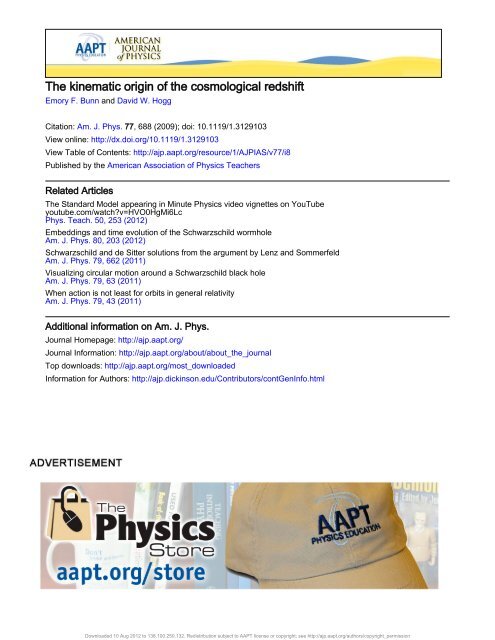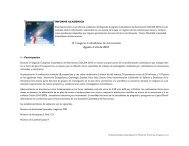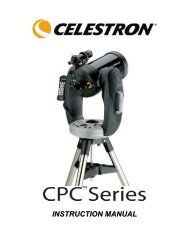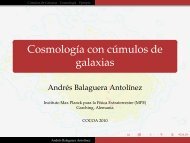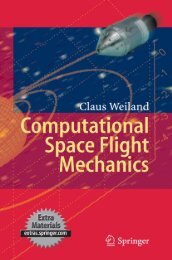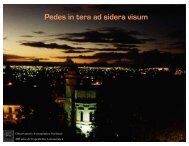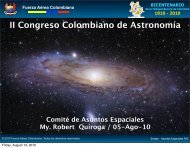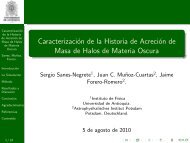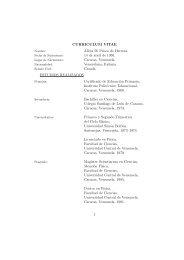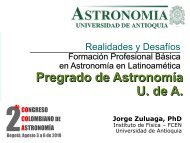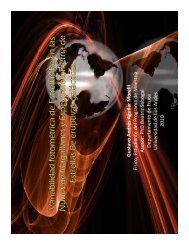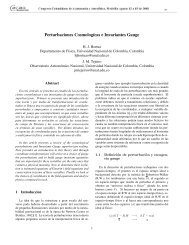The kinematic origin of the cosmological redshift
The kinematic origin of the cosmological redshift
The kinematic origin of the cosmological redshift
You also want an ePaper? Increase the reach of your titles
YUMPU automatically turns print PDFs into web optimized ePapers that Google loves.
<strong>The</strong> <strong>kinematic</strong> <strong>origin</strong> <strong>of</strong> <strong>the</strong> <strong>cosmological</strong> <strong>redshift</strong>Emory F. Bunn and David W. HoggCitation: Am. J. Phys. 77, 688 (2009); doi: 10.1119/1.3129103View online: http://dx.doi.org/10.1119/1.3129103View Table <strong>of</strong> Contents: http://ajp.aapt.org/resource/1/AJPIAS/v77/i8Published by <strong>the</strong> American Association <strong>of</strong> Physics TeachersRelated Articles<strong>The</strong> Standard Model appearing in Minute Physics video vignettes on YouTubeyoutube.com/watch?v=HVO0HgMi6LcPhys. Teach. 50, 253 (2012)Embeddings and time evolution <strong>of</strong> <strong>the</strong> Schwarzschild wormholeAm. J. Phys. 80, 203 (2012)Schwarzschild and de Sitter solutions from <strong>the</strong> argument by Lenz and SommerfeldAm. J. Phys. 79, 662 (2011)Visualizing circular motion around a Schwarzschild black holeAm. J. Phys. 79, 63 (2011)When action is not least for orbits in general relativityAm. J. Phys. 79, 43 (2011)Additional information on Am. J. Phys.Journal Homepage: http://ajp.aapt.org/Journal Information: http://ajp.aapt.org/about/about_<strong>the</strong>_journalTop downloads: http://ajp.aapt.org/most_downloadedInformation for Authors: http://ajp.dickinson.edu/Contributors/contGenInfo.htmlDownloaded 10 Aug 2012 to 138.100.250.132. Redistribution subject to AAPT license or copyright; see http://ajp.aapt.org/authors/copyright_permission
<strong>The</strong> <strong>kinematic</strong> <strong>origin</strong> <strong>of</strong> <strong>the</strong> <strong>cosmological</strong> <strong>redshift</strong>Emory F. Bunn aDepartment <strong>of</strong> Physics, University <strong>of</strong> Richmond, Richmond, Virginia 23173David W. HoggCenter for Cosmology and Particle Physics and Department <strong>of</strong> Physics, New York University,4 Washington Place, New York, New York 10003Received 7 August 2008; accepted 13 April 2009A common belief about big-bang cosmology is that <strong>the</strong> <strong>cosmological</strong> <strong>redshift</strong> cannot be properlyviewed as a Doppler shift that is, as evidence for a recession velocity but must be viewed in terms<strong>of</strong> <strong>the</strong> stretching <strong>of</strong> space. We argue that, contrary to this view, <strong>the</strong> most natural interpretation <strong>of</strong> <strong>the</strong><strong>redshift</strong> is as a Doppler shift, or ra<strong>the</strong>r as <strong>the</strong> accumulation <strong>of</strong> many infinitesimal Doppler shifts. <strong>The</strong>stretching-<strong>of</strong>-space interpretation obscures a central idea <strong>of</strong> relativity, namely that it is always validto choose a coordinate system that is locally Minkowskian. We show that an observed frequencyshift in any spacetime can be interpreted ei<strong>the</strong>r as a <strong>kinematic</strong> Doppler shift or a gravitational shiftby imagining a suitable family <strong>of</strong> observers along <strong>the</strong> photon’s path. In <strong>the</strong> context <strong>of</strong> <strong>the</strong> expandinguniverse, <strong>the</strong> <strong>kinematic</strong> interpretation corresponds to a family <strong>of</strong> comoving observers and hence ismore natural. © 2009 American Association <strong>of</strong> Physics Teachers.DOI: 10.1119/1.3129103I. INTRODUCTIONMany descriptions <strong>of</strong> big-bang cosmology declare that <strong>the</strong>observed <strong>redshift</strong> <strong>of</strong> distant galaxies is not a Doppler shiftbut is due to <strong>the</strong> “stretching <strong>of</strong> space.” <strong>The</strong> purpose <strong>of</strong> thispaper is to examine <strong>the</strong> meaning <strong>of</strong> such statements and toassess <strong>the</strong>ir validity. We wish to make clear at <strong>the</strong> outset thatwe are not suggesting any doubt about ei<strong>the</strong>r <strong>the</strong> observationsor <strong>the</strong> general-relativistic equations that successfullyexplain <strong>the</strong>m. Ra<strong>the</strong>r, our focus is on <strong>the</strong> interpretation: giventhat a photon does not arrive at <strong>the</strong> observer convenientlylabeled “Doppler shift,” “gravitational shift,” or “stretching<strong>of</strong> space,” when can or should we apply <strong>the</strong>se labels?Arguably, an enlightened cosmologist never asks thisquestion. In <strong>the</strong> curved spacetime <strong>of</strong> general relativity, <strong>the</strong>reis no unique way to compare vectors at widely separatedspacetime points, and hence <strong>the</strong> notion <strong>of</strong> <strong>the</strong> relative velocity<strong>of</strong> a distant galaxy is almost meaningless. Indeed, <strong>the</strong>inability to compare vectors at different points is <strong>the</strong> definition<strong>of</strong> a curved spacetime. 1–4 In practice, however, <strong>the</strong> enlightenedview is far from universal. <strong>The</strong> view presented bymany cosmologists and astrophysicists, particularly whentalking to nonspecialists, is that distant galaxies are “really”at rest and that <strong>the</strong> observed <strong>redshift</strong> is a consequence <strong>of</strong>some sort <strong>of</strong> “stretching <strong>of</strong> space,” which is distinct from <strong>the</strong>usual <strong>kinematic</strong> Doppler shift. In <strong>the</strong>se descriptions, statementsthat are artifacts <strong>of</strong> a particular coordinate system arepresented as if <strong>the</strong>y were statements about <strong>the</strong> universe, resultingin misunderstandings about <strong>the</strong> nature <strong>of</strong> spacetime inrelativity.In this paper, we will show that <strong>the</strong> <strong>redshift</strong>s <strong>of</strong> distantobjects in <strong>the</strong> expanding universe may be viewed as <strong>kinematic</strong>shifts due to relative velocities, and we will argue thatif we are forced to interpret <strong>the</strong> <strong>redshift</strong>, this interpretation ismore natural than any o<strong>the</strong>r.We begin with examples <strong>of</strong> <strong>the</strong> description <strong>of</strong> <strong>the</strong> <strong>cosmological</strong><strong>redshift</strong> in <strong>the</strong> first three introductory astronomy textbookschosen at random from <strong>the</strong> bookshelf <strong>of</strong> one <strong>of</strong> <strong>the</strong>authors.• <strong>The</strong> <strong>cosmological</strong> <strong>redshift</strong> “is not <strong>the</strong> same as a Dopplershift. Doppler shifts are caused by an object’s motionthrough space, whereas a <strong>cosmological</strong> <strong>redshift</strong> is causedby <strong>the</strong> expansion <strong>of</strong> space.” 5 Emphasis in <strong>origin</strong>al.• “A more accurate view than <strong>the</strong> Doppler effect <strong>of</strong> <strong>the</strong><strong>redshift</strong>s <strong>of</strong> galaxies is that <strong>the</strong> waves are stretched by <strong>the</strong>stretching <strong>of</strong> space <strong>the</strong>y travel through … If space isstretching during all <strong>the</strong> time <strong>the</strong> light is traveling, <strong>the</strong> lightwaves will be stretched as well.” 6• “Astronomers <strong>of</strong>ten express <strong>redshift</strong>s as if <strong>the</strong>y were radialvelocities, but <strong>the</strong> <strong>redshift</strong>s <strong>of</strong> <strong>the</strong> galaxies are not Dopplershifts … Einstein’s relativistic Doppler formula applies tomotion through space, so it does not apply to <strong>the</strong> recession<strong>of</strong> <strong>the</strong> galaxies.” 7More advanced textbooks <strong>of</strong>ten avoid this language. Forinstance, <strong>the</strong> books by Peacock 8 and Linder 9 give particularlycareful and clear descriptions <strong>of</strong> <strong>the</strong> nature <strong>of</strong> <strong>the</strong> <strong>cosmological</strong><strong>redshift</strong>. However, statements similar to those wehave cited can be found even in some advanced textbooks.For example, a leading advanced undergraduate level textstates that Doppler shifts “are produced by peculiar and notby recession velocities.” 10 In this paper, we argue, as o<strong>the</strong>rshave before us, 11–14 that statements such as <strong>the</strong>se are misleadingand foster misunderstandings about <strong>the</strong> nature <strong>of</strong>space and time.In general relativity, <strong>the</strong> “stretching <strong>of</strong> space” explanation<strong>of</strong> <strong>the</strong> <strong>redshift</strong> is quite problematic. Light is governed byMaxwell’s equations or <strong>the</strong>ir general relativistic generalization,which contain no “stretching <strong>of</strong> space term” and noinformation on <strong>the</strong> current size <strong>of</strong> <strong>the</strong> universe. On <strong>the</strong> contrary,one <strong>of</strong> <strong>the</strong> most important ideas <strong>of</strong> general relativity isthat spacetime is always locally indistinguishable from <strong>the</strong>nonstretching spacetime <strong>of</strong> special relativity, which meansthat a photon doesn’t know about <strong>the</strong> changing scale factor<strong>of</strong> <strong>the</strong> universe. 15<strong>The</strong> emphasis in many textbooks on <strong>the</strong> stretching-<strong>of</strong>spacetimeinterpretation <strong>of</strong> <strong>the</strong> <strong>cosmological</strong> <strong>redshift</strong> causesreaders to take too seriously <strong>the</strong> stretching-rubber-sheet analogyfor <strong>the</strong> expanding universe. For example, it is sometimesstated as if it were obvious that “it follows that all wave-688 Am. J. Phys. 77 8, August 2009 http://aapt.org/ajp © 2009 American Association <strong>of</strong> Physics Teachers 688Downloaded 10 Aug 2012 to 138.100.250.132. Redistribution subject to AAPT license or copyright; see http://ajp.aapt.org/authors/copyright_permission
lengths <strong>of</strong> <strong>the</strong> light ray are doubled” if <strong>the</strong> scale factordoubles. 10 Although this statement is correct, it is not obvious.After all, solutions to <strong>the</strong> Schrödinger equation, such as<strong>the</strong> electron orbitals in <strong>the</strong> hydrogen atom, don’t stretch as<strong>the</strong> universe expands, so why do solutions to Maxwell’sequations?A student presented with <strong>the</strong> stretching-<strong>of</strong>-space description<strong>of</strong> <strong>the</strong> <strong>redshift</strong> cannot be faulted for concluding, incorrectly,that hydrogen atoms, <strong>the</strong> Solar System, and <strong>the</strong> MilkyWay Galaxy must all constantly “resist <strong>the</strong> temptation” toexpand along with <strong>the</strong> universe. One way to see that thisbelief is in error is to consider <strong>the</strong> problem sometimes knownas <strong>the</strong> “te<strong>the</strong>red galaxy problem,” 16,17 in which a galaxy iste<strong>the</strong>red to <strong>the</strong> Milky Way, forcing <strong>the</strong> distance between <strong>the</strong>two to remain constant. When <strong>the</strong> te<strong>the</strong>r is cut, does <strong>the</strong>galaxy join up with <strong>the</strong> Hubble flow and start to recede dueto <strong>the</strong> expansion <strong>of</strong> <strong>the</strong> universe? <strong>The</strong> intuition that says thatobjects suffer from a temptation to be swept up in <strong>the</strong> expansion<strong>of</strong> <strong>the</strong> universe will lead to an affirmative answer, but<strong>the</strong> truth is <strong>the</strong> reverse: unless <strong>the</strong>re is a large <strong>cosmological</strong>constant and <strong>the</strong> galaxy’s distance is comparable to <strong>the</strong>Hubble length, <strong>the</strong> galaxy falls toward us. 13,14 Similarly, it iscommonly believed that <strong>the</strong> Solar System has a very slighttendency to expand due to <strong>the</strong> Hubble expansion althoughthis tendency is generally thought to be negligible in practice.Again, explicit calculation shows this belief not to becorrect. 18,19 <strong>The</strong> tendency to expand due to <strong>the</strong> stretching <strong>of</strong>space is nonexistent, not merely negligible.<strong>The</strong> expanding rubber sheet is quite similar to <strong>the</strong> e<strong>the</strong>r <strong>of</strong>prerelativity physics in that although it is intuitively appealing,it makes no correct testable predictions and some incorrectones, such as <strong>the</strong> examples we have given. It <strong>the</strong>reforehas no rightful place in <strong>the</strong> <strong>the</strong>ory. Some authors 20,21 haveargued that considerations such as <strong>the</strong>se do not refute <strong>the</strong>notion that space is really expanding. We agree with <strong>the</strong> calculationsin <strong>the</strong>se papers but differ regarding <strong>the</strong> most usefullanguage to use to describe <strong>the</strong> relevant phenomena.In one set <strong>of</strong> circumstances, <strong>the</strong> proper interpretation <strong>of</strong><strong>the</strong> <strong>redshift</strong> seems clear. When <strong>the</strong> curvature <strong>of</strong> spacetime issmall over <strong>the</strong> distance and time scales traveled by a photon,it is natural to interpret <strong>the</strong> observed frequency shift as aDoppler shift. This interpretation is <strong>the</strong> reason that a police<strong>of</strong>ficer can give you a speeding ticket based on <strong>the</strong> readingon a radar gun. As far as we know, no one has successfullyargued in traffic court that <strong>the</strong>re is an ambiguity in interpreting<strong>the</strong> observed frequency shift as a Doppler shift. 22 In <strong>the</strong>expanding universe, spacetime curvature is small over regionsencompassing nearby objects, specifically those withz=/1. <strong>The</strong>re should be no hesitation about calling <strong>the</strong>observed <strong>redshift</strong>s Doppler shifts in this case, just as <strong>the</strong>re isnone in traffic court. Surprisingly, however, many peopleseem to believe that <strong>the</strong> “stretching <strong>of</strong> space” interpretation<strong>of</strong> <strong>the</strong> <strong>redshift</strong> is <strong>the</strong> only valid one, even in this limit. Wewill examine <strong>the</strong> interpretation <strong>of</strong> <strong>redshift</strong>s <strong>of</strong> nearby objectsmore carefully in Sec. II.Aside from low-<strong>redshift</strong> sources, <strong>the</strong>re is ano<strong>the</strong>r case inwhich spacetime curvature can be neglected in considering<strong>cosmological</strong> <strong>redshift</strong>s, namely, low-density <strong>cosmological</strong>models. An expanding universe with density =0 <strong>of</strong>tenknown as <strong>the</strong> Milne model 23 is merely <strong>the</strong> flat Minkowskispacetime <strong>of</strong> special relativity expressed in nonstandardcoordinates. 24 In an =0 universe, <strong>the</strong>re are no gravitationaleffects at all, so any observed <strong>redshift</strong>, even <strong>of</strong> a very distantgalaxy, must be a Doppler shift. Fur<strong>the</strong>rmore, for low butnonzero density 1, <strong>the</strong> length scale associated withspacetime curvature is much longer than <strong>the</strong> horizon distance.Hence, spacetime curvature effects that is, gravitationaleffects are weak throughout <strong>the</strong> observable volume,and <strong>the</strong> special-relativistic Doppler shift interpretation remainsvalid even for galaxies with arbitrarily high <strong>redshift</strong>s.<strong>The</strong> more interesting cases are when z and are notsmall, that is, when <strong>the</strong> source is sufficiently distant thatgravitational effects are important over <strong>the</strong> photon’s trajectory.<strong>The</strong> consensus is that <strong>the</strong> Doppler shift language mustbe eschewed in this setting. In Sec. III, we review a standardargument 8,13 that even in this case <strong>the</strong> <strong>redshift</strong> can be interpretedas <strong>the</strong> accumulation <strong>of</strong> infinitesimal Doppler shiftsalong <strong>the</strong> line <strong>of</strong> sight, and we fur<strong>the</strong>r argue that <strong>the</strong>re is anatural way to interpret <strong>the</strong> <strong>redshift</strong> as a single noninfinitesimalDoppler shift.A common objection to this claim is that <strong>the</strong> coordinatevelocity is not related to <strong>the</strong> <strong>redshift</strong> in accordance with <strong>the</strong>special-relativistic Doppler formula. 25,26 However, <strong>the</strong> velocityreferred to in this claim is a mere artifact <strong>of</strong> a particularchoice <strong>of</strong> time coordinate. Specifically, it is <strong>the</strong> rate <strong>of</strong>change <strong>of</strong> <strong>the</strong> distance to <strong>the</strong> object with respect to <strong>the</strong> cosmictime coordinate, as measured at <strong>the</strong> present cosmic time.This coordinate velocity is an unnatural quantity to discuss,because it depends on data outside <strong>of</strong> <strong>the</strong> observer’s lightcone. <strong>The</strong> more natural velocity is <strong>the</strong> velocity <strong>of</strong> <strong>the</strong> objectat <strong>the</strong> time it crossed our past light cone, relative to us today.This velocity is also a coordinate-dependent concept, but aswe will show in Sec. III, <strong>the</strong> most natural way to specify itoperationally 27,28 leads to a result that is consistent with <strong>the</strong>special-relativistic Doppler formula.In Sec. IV, we widen our focus to consider frequencyshifts in arbitrary curved spacetimes. In any curved spacetime<strong>the</strong> observed frequency shift in a photon can be interpretedas ei<strong>the</strong>r a <strong>kinematic</strong> effect a Doppler shift or as agravitational shift. <strong>The</strong> two interpretations arise from differentchoices <strong>of</strong> coordinates or, equivalently, from imaginingdifferent families <strong>of</strong> observers along <strong>the</strong> photon’s path. Wewill describe this construction explicitly and show that <strong>the</strong>comoving observers who are usually used to describe phenomenain <strong>the</strong> expanding universe are <strong>the</strong> ones that correspondto <strong>the</strong> Doppler shift interpretation.II. REDSHIFTS OF NEARBY GALAXIES AREDOPPLER SHIFTSWe begin by returning to <strong>the</strong> parable <strong>of</strong> <strong>the</strong> speedingticket, mentioned in Sec. I.A driver is pulled over for speeding. <strong>The</strong> police<strong>of</strong>ficer says to <strong>the</strong> driver, “According to <strong>the</strong> Dopplershift <strong>of</strong> <strong>the</strong> radar signal I bounced <strong>of</strong>f your car,you were traveling faster than <strong>the</strong> speed limit.”<strong>The</strong> driver replies, “In certain coordinate systems,<strong>the</strong> distance between us remained constant during<strong>the</strong> time <strong>the</strong> radar signal was propagating. In sucha coordinate system, our relative velocity is zero,and <strong>the</strong> observed wavelength shift was not a Dopplershift. So you can’t give me a ticket.”If you believe that <strong>the</strong> driver has a legitimate argument,689 Am. J. Phys., Vol. 77, No. 8, August 2009Emory F. Bunn and David W. Hogg 689Downloaded 10 Aug 2012 to 138.100.250.132. Redistribution subject to AAPT license or copyright; see http://ajp.aapt.org/authors/copyright_permission
1.001.00.80.950.6a0.4t0.900.850.800.00 0.05 0.10 0.15 0.20(a)r0.000.20.00.0 0.2 0.4 0.6 0.8 1.0tFig. 2. <strong>The</strong> scale factor <strong>of</strong> a hypo<strong>the</strong>tical “loitering” universe as a function<strong>of</strong> time measured in units <strong>of</strong> <strong>the</strong> present time. At <strong>the</strong> time indicated by <strong>the</strong>dot, a galaxy emits radiation, which is observed at <strong>the</strong> present time. At <strong>the</strong>times <strong>of</strong> both emission and observation, <strong>the</strong> expansion is very slow, yet <strong>the</strong>galaxy’s observed <strong>redshift</strong> is large.T0.050.100.150.200.00 0.05 0.10 0.15 0.20(b)RFig. 1. Spacetime in different coordinate systems. a Plot <strong>of</strong> an expandingRobertson–Walker universe in <strong>the</strong> usual comoving coordinates r,t. Coordinatesare expressed in units <strong>of</strong> <strong>the</strong> Hubble length and time. <strong>The</strong> observer islocated at r=0. <strong>The</strong> dotted curves show <strong>the</strong> world lines <strong>of</strong> a particulargalaxy and <strong>of</strong> a light signal from that galaxy reaching <strong>the</strong> observer at <strong>the</strong>present time t=1. <strong>The</strong> dashed and solid curves are contours <strong>of</strong> constantRiemann normal coordinates R,T; that is, <strong>the</strong> coordinates that approximateflat spacetime as well as possible near <strong>the</strong> observer. b <strong>The</strong> roles <strong>of</strong> <strong>the</strong> twocoordinate systems are reversed: <strong>the</strong> coordinate axes are <strong>the</strong> Riemann normalcoordinates R,T, and <strong>the</strong> dashed and solid curves are contours <strong>of</strong>constant comoving coordinates r,t. As time passes, <strong>the</strong> galaxy moves tolarger values <strong>of</strong> R; that is, it is not at rest in this coordinate system.Let us begin by reviewing a standard derivation 8,13 <strong>of</strong> <strong>the</strong><strong>cosmological</strong> <strong>redshift</strong>. Consider a photon that travels from agalaxy to a distant observer, both <strong>of</strong> whom are at rest incomoving coordinates. Imagine a family <strong>of</strong> comoving observersalong <strong>the</strong> photon’s path, each <strong>of</strong> whom measures <strong>the</strong>photon’s frequency as it goes by. We assume that each observeris close enough to his neighbor so that we can accommodate<strong>the</strong>m both in one inertial reference frame and usespecial relativity to calculate <strong>the</strong> change in frequency fromone observer to <strong>the</strong> next. If adjacent observers are separatedby <strong>the</strong> small distance r, <strong>the</strong>n <strong>the</strong>ir relative speed in thisframe is v=Hr, where H is <strong>the</strong> Hubble parameter. Thisspeed is much less than c, so <strong>the</strong> frequency shift is given by<strong>the</strong> nonrelativistic Doppler formula/ =−v/c =−Hr/c =−Ht.4We know that H=ȧ/a, where a is <strong>the</strong> scale factor. We concludethat <strong>the</strong> frequency change is given by /=−a/a;that is, <strong>the</strong> frequency decreases in inverse proportion to <strong>the</strong>scale factor. <strong>The</strong> overall <strong>redshift</strong> is <strong>the</strong>refore given by1+z t et o = at oat e ,5where t e and t o refer to <strong>the</strong> times <strong>of</strong> emission and observation,respectively.In this derivation, we interpret <strong>the</strong> <strong>redshift</strong> as <strong>the</strong> accumulatedeffect <strong>of</strong> many small Doppler shifts along <strong>the</strong> photon’spath. We now address <strong>the</strong> question <strong>of</strong> whe<strong>the</strong>r it makes senseto interpret <strong>the</strong> <strong>redshift</strong> as one big Doppler shift ra<strong>the</strong>r than<strong>the</strong> sum <strong>of</strong> many small ones.Figure 2 shows a common argument against such an interpretation.Imagine a universe whose expansion rate varieswith time as shown in Fig. 2. A galaxy emits radiation at <strong>the</strong>time t e indicated by <strong>the</strong> dot, and <strong>the</strong> radiation reaches anobserver at <strong>the</strong> present time t 0 . <strong>The</strong> observed <strong>redshift</strong> is z=at 0 /at e −1=1.5, which by <strong>the</strong> special-relativistic Dopplerformula would correspond to a speed <strong>of</strong> 0.72c. At <strong>the</strong>times <strong>of</strong> emission and absorption <strong>of</strong> <strong>the</strong> radiation, <strong>the</strong> expansionrate is very slow, and <strong>the</strong> speed ȧr <strong>of</strong> <strong>the</strong> galaxy is<strong>the</strong>refore much less than this value. We can construct modelsin which both ȧt e and ȧt 0 are arbitrarily small withoutchanging <strong>the</strong> ratio at 0 /at e and hence without changing<strong>the</strong> <strong>redshift</strong>.Upon closer examination, this argument is unconvincing,because <strong>the</strong> calculated velocities are not <strong>the</strong> correct velocities.We should not calculate velocities at a fixed instant <strong>of</strong>cosmic time ei<strong>the</strong>r t=t e or t=t 0 . Instead, we should calculate<strong>the</strong> velocity <strong>of</strong> <strong>the</strong> galaxy at <strong>the</strong> time <strong>of</strong> light emissionrelative to <strong>the</strong> observer at <strong>the</strong> present time. After all, if adistant galaxy’s <strong>redshift</strong> is measured today, we wouldn’t expect<strong>the</strong> result to depend on what <strong>the</strong> galaxy is doing todaynor on what <strong>the</strong> observer was doing long before <strong>the</strong> age <strong>of</strong><strong>the</strong> dinosaurs.In fact, when astrophysicists talk about what a distant objectis doing “now,” <strong>the</strong>y <strong>of</strong>ten do not mean at <strong>the</strong> presentvalue <strong>of</strong> <strong>the</strong> cosmic time but ra<strong>the</strong>r at <strong>the</strong> time <strong>the</strong> objectcrossed our past light cone. For instance, when astronomersmeasure <strong>the</strong> orbital speeds <strong>of</strong> planets orbiting o<strong>the</strong>r stars, <strong>the</strong>measured velocities are always <strong>of</strong> this sort. <strong>The</strong>re is an excellentreason for this convention: we never have informationabout what a distant object is doing or if <strong>the</strong> object evenexists at <strong>the</strong> present cosmic time. Any statement in which“now” is used to refer to <strong>the</strong> present cosmic time at <strong>the</strong>location <strong>of</strong> a distant object is not about anything observable,because it refers to events far outside our light cone.691 Am. J. Phys., Vol. 77, No. 8, August 2009Emory F. Bunn and David W. Hogg 691Downloaded 10 Aug 2012 to 138.100.250.132. Redistribution subject to AAPT license or copyright; see http://ajp.aapt.org/authors/copyright_permission
t1.00.80.60.40.0 0.2 0.4 0.6 0.8 1.0 1.2 1.4rFig. 3. Parallel transport <strong>of</strong> <strong>the</strong> velocity four-vector. <strong>The</strong> solid and dashedlines show <strong>the</strong> world line <strong>of</strong> a galaxy and <strong>the</strong> path <strong>of</strong> radiation from <strong>the</strong>galaxy to <strong>the</strong> observer in comoving coordinates. <strong>The</strong> short solid lines show<strong>the</strong> galaxy’s four-velocity being parallel transported to <strong>the</strong> observer along<strong>the</strong> path <strong>of</strong> <strong>the</strong> light.In summary, if we wish to discuss <strong>the</strong> <strong>redshift</strong> <strong>of</strong> a distantgalaxy as a Doppler shift, we need to be willing to talk aboutv rel , <strong>the</strong> velocity <strong>of</strong> <strong>the</strong> galaxy <strong>the</strong>n relative to us now. Talkingabout v rel is precisely <strong>the</strong> sort <strong>of</strong> thing that <strong>the</strong> enlightenedcosmologist described in Sec. I refuses to do, because,in a curved spacetime, <strong>the</strong>re is not a unique way to define <strong>the</strong>relative velocity <strong>of</strong> objects at widely separated spacetimeevents. Determining <strong>the</strong> velocity <strong>of</strong> one object relative toano<strong>the</strong>r involves comparing <strong>the</strong> two objects’ velocity fourvectors.To be specific, <strong>the</strong> dot product <strong>of</strong> <strong>the</strong>se vectors is rel 1−v 2 rel /c 2 −1/2 . To do that, we have to transport one <strong>of</strong><strong>the</strong> vectors to <strong>the</strong> location <strong>of</strong> <strong>the</strong> o<strong>the</strong>r. In a curved spacetime,<strong>the</strong> result <strong>of</strong> such a “parallel transport” depends on <strong>the</strong>path along which <strong>the</strong> vector is transported.Suppose that we wish to defy <strong>the</strong> purist and talk about v rel .We have to parallel transport <strong>the</strong> galaxy’s velocity fourvectorto <strong>the</strong> observer’s location. As o<strong>the</strong>rs have noted, 27,28<strong>the</strong> only natural path to choose for this parallel transport is<strong>the</strong> path followed by <strong>the</strong> light that is, <strong>the</strong> null geodesic joining<strong>the</strong> emission and observation events. If we follow thisprocedure to determine <strong>the</strong> relative velocity, we find that <strong>the</strong>velocity obeys <strong>the</strong> rulec + v rel= at oc − v rel at e .As noted in Eq. 5, <strong>the</strong> ratio <strong>of</strong> scale factors is equal to 1+z, so Eq. 6 is <strong>the</strong> special-relativistic Doppler formula. Ino<strong>the</strong>r words, <strong>the</strong> relative speed v rel as defined by paralleltransport is related to <strong>the</strong> observed <strong>redshift</strong> as it should be if<strong>the</strong> <strong>redshift</strong> is a Doppler shift.Figure 3 illustrates this process. <strong>The</strong> solid line is <strong>the</strong> worldline <strong>of</strong> a galaxy, and <strong>the</strong> dashed line is <strong>the</strong> path <strong>of</strong> lighttraveling from <strong>the</strong> galaxy to <strong>the</strong> observer. <strong>The</strong> scale factor isas shown in Fig. 2. <strong>The</strong> short solid lines indicate <strong>the</strong> galaxy’svelocity four-vector as it is parallel transported along <strong>the</strong>light path to <strong>the</strong> observer. During <strong>the</strong> times when <strong>the</strong> universeis expanding slowly <strong>the</strong> direction <strong>of</strong> this vector doesn’tchange significantly, but it does when <strong>the</strong> universe expandsmore rapidly.Equation 6 can be derived by a straightforward calculationusing <strong>the</strong> rules for parallel transport, but <strong>the</strong> derivation iseasier if we recast <strong>the</strong> statement in more physical terms. Aswe did at <strong>the</strong> beginning <strong>of</strong> this section, imagine many comovingobservers stationed along <strong>the</strong> line from <strong>the</strong> observedgalaxy to <strong>the</strong> observer. Each observer has a local referenceframe in which special relativity can be taken to apply, and6<strong>the</strong> observers are close enough toge<strong>the</strong>r that each one lieswithin <strong>the</strong> local frame <strong>of</strong> his neighbor. Observer number 1,who is located near <strong>the</strong> <strong>origin</strong>al galaxy, measures its speed v 1relative to him and gives this information to observer 2. Observer2 measures <strong>the</strong> speed u <strong>of</strong> observer 1 relative to her,adds this speed to <strong>the</strong> speed <strong>of</strong> <strong>the</strong> galaxy relative to observer1 using <strong>the</strong> usual special-relativistic formula,v 2 =v 1 + u1+v 1 u/c 2 , 7and interprets <strong>the</strong> result as v rel , <strong>the</strong> speed <strong>of</strong> <strong>the</strong> galaxy relativeto her. She passes this information on to <strong>the</strong> next observer,who follows <strong>the</strong> same procedure, as does each subsequentobserver. At each stage, <strong>the</strong> imputed velocity <strong>of</strong> <strong>the</strong><strong>origin</strong>al galaxy relative to <strong>the</strong> observer will match <strong>the</strong> <strong>redshift</strong><strong>of</strong> <strong>the</strong> galaxy in accordance with Eq. 6. <strong>The</strong> procedurewe have described operationally is equivalent to performingparallel transport <strong>of</strong> <strong>the</strong> galaxy’s four-velocity and using thatvector at each stage to calculate v rel .We can express this derivation in yet ano<strong>the</strong>r way. Consider<strong>the</strong> “world tube” obtained by drawing a sphere with asmall radius around each point on <strong>the</strong> path <strong>of</strong> <strong>the</strong> light rayfrom <strong>the</strong> galaxy to <strong>the</strong> observer. This region <strong>of</strong> spacetime canbe considered as flat Minkowski spacetime up to errors <strong>of</strong>order 2 . This statement is true for any small neighborhoodaround a geodesic. Within this tube, <strong>the</strong> observed <strong>redshift</strong>can be explained only as a Doppler shift, because <strong>the</strong> spacetimeis flat to arbitrary precision. This argument supplies <strong>the</strong>simplest pro<strong>of</strong> we can think <strong>of</strong> that v rel is related to <strong>the</strong> <strong>redshift</strong>by Eq. 6.We do not expect to have convinced purists who refuseeven to talk about v rel to change <strong>the</strong>ir minds. <strong>The</strong>y woulddismiss v rel as a mere “coordinate velocity,” not an “actualvelocity,” and take no interest in it. If purists have <strong>the</strong> courage<strong>of</strong> <strong>the</strong>ir convictions, <strong>the</strong>y would say that it makes nosense to try to attach labels such as “Doppler” or “gravitational”to <strong>the</strong> observed <strong>redshift</strong>. This position is unassailable,and we have no wish to argue against it. We do claim, however,that if you wish to try to talk about v rel , <strong>the</strong>n <strong>the</strong> definitionproposed in this section is <strong>the</strong> most natural way to doso. Because this definition <strong>of</strong> v rel results in <strong>the</strong> Doppler formulaentirely explaining <strong>the</strong> <strong>redshift</strong>, we claim that youshould ei<strong>the</strong>r be a purist and refuse to try to label <strong>the</strong> <strong>cosmological</strong><strong>redshift</strong>, or you should label it a Doppler shift.It is interesting to contrast <strong>the</strong> position we advocate withano<strong>the</strong>r approach 13,29 that describes <strong>the</strong> <strong>cosmological</strong> <strong>redshift</strong>as a particular combination <strong>of</strong> Doppler and gravitationalterms. In that approach, comoving coordinates are used tospecify <strong>the</strong> velocity <strong>of</strong> <strong>the</strong> distant galaxy relative to <strong>the</strong> observer,and <strong>the</strong> observed <strong>redshift</strong> is decomposed into a Dopplerterm based on this velocity and a gravitational blueshift,which can be calculated by considering <strong>the</strong> gravitational potentialdue to <strong>the</strong> matter in a sphere centered on <strong>the</strong> observer.<strong>The</strong> difference between <strong>the</strong> two approaches is in <strong>the</strong> way <strong>the</strong>velocity is defined. Because <strong>the</strong>re is no unique specification<strong>of</strong> relative velocity for distant objects in curved spacetime,both approaches are correct. We believe that <strong>the</strong> approachbased on defining v rel through parallel transport is more naturalthan <strong>the</strong> one based on a particular choice <strong>of</strong> coordinates.692 Am. J. Phys., Vol. 77, No. 8, August 2009Emory F. Bunn and David W. Hogg 692Downloaded 10 Aug 2012 to 138.100.250.132. Redistribution subject to AAPT license or copyright; see http://ajp.aapt.org/authors/copyright_permission
IV. KINEMATIC AND GRAVITATIONAL REDSHIFTSIN GENERAL SPACETIMESLet us step back from <strong>the</strong> specific case <strong>of</strong> <strong>the</strong> expandinguniverse and consider <strong>the</strong> propagation <strong>of</strong> a photon in an arbitraryspacetime. A photon is emitted at some spacetimepoint P e with a frequency e and is absorbed at P a withfrequency a . <strong>The</strong> two frequencies are measured by observersin local inertial reference frames at <strong>the</strong> two spacetimepoints. If <strong>the</strong>re is a frequency shift e a , under whatcircumstances should we describe it as a Doppler shift or asa gravitational shift?A natural way to answer this question is to populate <strong>the</strong>space between <strong>the</strong> photon’s emission and observation with adense family <strong>of</strong> observers. Let <strong>the</strong> first observer be at restrelative to <strong>the</strong> emitter <strong>of</strong> <strong>the</strong> photon at <strong>the</strong> emission event,and let <strong>the</strong> last be at rest relative to <strong>the</strong> absorber at <strong>the</strong> absorptionevent. Finally, let <strong>the</strong> velocities <strong>of</strong> observers varysmoothly along <strong>the</strong> photon’s path. As in Sec. III, we canexplain <strong>the</strong> observed frequency shift by adding up <strong>the</strong> shiftsas <strong>the</strong> photon passes from one observer to <strong>the</strong> next. We canconstruct two such families <strong>of</strong> observers: one in which each<strong>of</strong> <strong>the</strong> shifts is a Doppler shift, and one in which each is agravitational shift. By reference to <strong>the</strong>se families, we caninterpret <strong>the</strong> observed shift as <strong>the</strong> accumulation <strong>of</strong> ei<strong>the</strong>rmany small Doppler shifts or many small gravitational shifts.<strong>The</strong> Doppler and gravitational families are not <strong>the</strong> onlypossibilities. We can construct o<strong>the</strong>r families with respect towhom both Doppler and gravitational shifts would be seen tocontribute. As noted in Sec. III, for example, one way <strong>of</strong>regarding <strong>the</strong> <strong>cosmological</strong> <strong>redshift</strong> 13,29 splits it into a specificcombination <strong>of</strong> Doppler and gravitational terms. <strong>The</strong>Doppler and gravitational families provide two <strong>of</strong> many differentways <strong>of</strong> interpreting <strong>the</strong> observed shift. In any givensituation, we can argue about which if ei<strong>the</strong>r <strong>of</strong> <strong>the</strong> tw<strong>of</strong>amilies is natural to consider.To construct <strong>the</strong> Doppler family <strong>of</strong> observers, we requireall observers to be in free fall. In this case, within each localinertial frame, <strong>the</strong>re are no gravitational effects, and hence<strong>the</strong> infinitesimal frequency shift from each observer to <strong>the</strong>next is a Doppler shift.To construct <strong>the</strong> gravitational family <strong>of</strong> observers, we requirethat each member be at rest relative to her neighbor at<strong>the</strong> moment <strong>the</strong> photon passes by, so that <strong>the</strong>re are noDoppler shifts. Initially, it might seem impossible in generalto satisfy this condition simultaneously with <strong>the</strong> conditionthat <strong>the</strong> first and last observers be at rest relative to <strong>the</strong> emitterand absorber, but it is always possible to do so. One wayto see that it is possible is to draw a small world tube around<strong>the</strong> photon path as in Sec. III. Within this tube, spacetime isarbitrarily close to flat. We can construct “Rindler elevatorcoordinates,” <strong>the</strong> special-relativistic generalization <strong>of</strong> aframe moving with uniform acceleration, within this tube,such that <strong>the</strong> velocities at <strong>the</strong> two ends match up correctly. 30<strong>The</strong> members <strong>of</strong> <strong>the</strong> gravitational family are at rest in <strong>the</strong>secoordinates. Because <strong>the</strong>y are not in free fall, <strong>the</strong> members <strong>of</strong><strong>the</strong> gravitational family all feel like <strong>the</strong>y are in local gravitationalfields. Because each has zero velocity relative to herneighbor when <strong>the</strong> photon goes by, each observer interprets<strong>the</strong> shift in <strong>the</strong> photon’s frequency relative to her neighbor asa gravitational shift.Because <strong>the</strong> two families exist for any photon path, we canalways describe any frequency shift as ei<strong>the</strong>r Doppler orgravitational. In some situations, one seems clearly morenatural than <strong>the</strong> o<strong>the</strong>r. When we discuss <strong>the</strong> Pound–Rebkaexperiment, 31 which measured <strong>the</strong> <strong>redshift</strong> <strong>of</strong> photons movingupward in Earth’s gravitational field, we generallychoose to regard observers fixed relative to <strong>the</strong> Earth <strong>the</strong>gravitational family as more natural than free-fall observers,and hence we interpret <strong>the</strong> measurement as a gravitational<strong>redshift</strong>. In contrast, if you were falling past Pound and Rebkain a freely falling elevator as <strong>the</strong>y performed <strong>the</strong> experiment,you might choose a Minkowskian inertial frame encompassingyou and <strong>the</strong> entire experiment. Within thisframe, you would, by <strong>the</strong> equivalence principle, interpret<strong>the</strong>ir results as a Doppler shift. In so doing, you would bechoosing to regard <strong>the</strong> Doppler family as <strong>the</strong> natural one,because this family is <strong>the</strong> one whose behavior is simplest todescribe in your chosen frame. Finally, if you tried to beat aspeeding ticket by claiming that <strong>the</strong> radar results were due toa gravitational <strong>redshift</strong>, you would in effect be considering a“gravitational family” <strong>of</strong> prodigiously accelerating observers,with one at rest relative to <strong>the</strong> radar gun and one at restrelative to <strong>the</strong> driver. Needless to say, <strong>the</strong> police <strong>of</strong>ficer whogives you a ticket regards this family as extremely unnatural.In <strong>the</strong> <strong>cosmological</strong> context, we almost always work withfreely falling comoving observers, a choice which correspondsprecisely to <strong>the</strong> Doppler family. This choice is naturalbecause it respects <strong>the</strong> symmetries <strong>of</strong> <strong>the</strong> spacetime andmakes <strong>the</strong> ma<strong>the</strong>matical description as simple as possible.On <strong>the</strong> o<strong>the</strong>r hand, <strong>the</strong> gravitational family is so unnatural incosmology that, as far as we know, it has never been used foranything. Because <strong>the</strong> Doppler family is by far <strong>the</strong> mostnatural family to work with, it is natural to interpret <strong>the</strong><strong>cosmological</strong> <strong>redshift</strong> as a Doppler shift, and it is curious thatthis interpretation is frequently frowned upon.V. WHY THE INTERPRETATION MATTERS<strong>The</strong>re is no “fact <strong>of</strong> <strong>the</strong> matter” about <strong>the</strong> interpretation <strong>of</strong><strong>the</strong> <strong>cosmological</strong> <strong>redshift</strong>: what one concludes depends onone’s coordinate system or method <strong>of</strong> calculation. None<strong>the</strong>less,it is instructive to analyze <strong>the</strong> differing interpretations <strong>of</strong><strong>the</strong> <strong>redshift</strong>, partly to improve <strong>the</strong> understanding <strong>of</strong> cosmology,but more importantly to improve <strong>the</strong> understanding <strong>of</strong>general relativity. That analysis leads us to conclude that <strong>the</strong>most natural interpretation <strong>of</strong> <strong>the</strong> <strong>redshift</strong> is <strong>kinematic</strong>.One <strong>of</strong> <strong>the</strong> key ideas <strong>of</strong> general relativity is <strong>the</strong> importance<strong>of</strong> distinguishing between coordinate-independent andcoordinate-dependent statements. Ano<strong>the</strong>r is <strong>the</strong> idea thatspacetime is always locally indistinguishable fromMinkowski spacetime. Cosmology instructors, books especiallyat <strong>the</strong> introductory level, and students <strong>of</strong>ten fall into<strong>the</strong> fallacy <strong>of</strong> reifying <strong>the</strong> rubber sheet; that is, treating <strong>the</strong>expanding-rubber-sheet model <strong>of</strong> space as if it were a realsubstance. This error leads people away from both <strong>of</strong> <strong>the</strong>sekey ideas and causes mistaken intuitions such as that <strong>the</strong>Milky Way Galaxy must constantly “resist <strong>the</strong> temptation” toexpand with <strong>the</strong> expanding universe or that <strong>the</strong> “te<strong>the</strong>redgalaxy” described in Sec. I moves away after <strong>the</strong> te<strong>the</strong>r iscut.<strong>The</strong> common belief that <strong>the</strong> <strong>cosmological</strong> <strong>redshift</strong> canonly be explained in terms <strong>of</strong> <strong>the</strong> stretching <strong>of</strong> space is basedon conflating <strong>the</strong> properties <strong>of</strong> a specific coordinate systemwith properties <strong>of</strong> space itself. This confusion is precisely <strong>the</strong>opposite <strong>of</strong> <strong>the</strong> correct frame <strong>of</strong> mind in which to understandrelativity.693 Am. J. Phys., Vol. 77, No. 8, August 2009Emory F. Bunn and David W. Hogg 693Downloaded 10 Aug 2012 to 138.100.250.132. Redistribution subject to AAPT license or copyright; see http://ajp.aapt.org/authors/copyright_permission
ACKNOWLEDGMENTS<strong>The</strong> authors thank Sean Carroll, John Peacock, JimPeebles, Dave Spiegel, and Ned Wright for helpful comments.This work was supported in part by NSF Grant No.AST-0507395 EFB and a research fellowship from <strong>the</strong> Alexandervon Humboldt Foundation <strong>of</strong> Germany DWH.a Electronic mail: ebunn@richmond.edu1 J. C. Baez and E. F. Bunn, “<strong>The</strong> meaning <strong>of</strong> Einstein’s equation,” Am. J.Phys. 73, 644–652 2005.2 S. Carroll, Spacetime and Geometry: An Introduction to General RelativityBenjamin Cummings, San Francisco, 2003.3 B. F. Schutz, A First Course in General Relativity Cambridge U.P., Cambridge,1985.4 C. W. Misner, K. S. Thorne, and J. A. Wheeler, Gravitation W. H.Freeman, New York, 1973.5 W. J. Kaufmann and R. Freedman, Universe, 5th ed. W. H. Freeman,New York, 1999.6 A. Fraknoi, D. Morrison, and S. Wolff, Voyages Through <strong>the</strong> Universe,3rd ed. Thomson Brooks/Cole, Belmont, CA, 2004.7 M. A. Seeds, Foundations <strong>of</strong> Astronomy, 10th ed. Thomson Brooks/Cole, Belmont, CA, 2007.8 J. Peacock, Cosmological Physics Cambridge U.P., Cambridge, 1998.9 E. V. Linder, First Principles <strong>of</strong> Cosmology Addison-Wesley, Reading,MA, 1997.10 E. Harrison, Cosmology, 2nd ed. Cambridge U.P., Cambridge, 2000.11 M. Chodorowski, “Is space really expanding? A counterexample,” ConceptsPhys. 4, 15–33 2007 arXiv:astro-ph/0601171.12 M. J. Chodorowski, “A direct consequence <strong>of</strong> <strong>the</strong> expansion <strong>of</strong> space?,”Mon. Not. R. Astron. Soc. 378, 239–244 2007.13 J. A. Peacock, “A diatribe on expanding space,” arXiv:0809.4573.14 A. B. Whiting, “<strong>The</strong> expansion <strong>of</strong> space: free-particle motion and <strong>the</strong><strong>cosmological</strong> <strong>redshift</strong>,” Observatory 124, 174–189 2004.15 One might argue against this claim by noting that <strong>the</strong> general relativisticMaxwell equations contain covariant derivatives, which “know about”<strong>the</strong> expansion. However, covariant derivatives are locally indistinguishablefrom ordinary derivatives because a local Minkowski frame canalways be chosen.16 E. R. Harrison, “Mining energy in an expanding universe,” Astrophys. J.446, 63–66 1995.17 T. M. Davis, C. H. Lineweaver, and J. K. Webb, “Solutions to <strong>the</strong> te<strong>the</strong>redgalaxy problem in an expanding universe and <strong>the</strong> observation <strong>of</strong>receding blueshifted objects,” arXiv:astro-ph/0104349.18 M. Sereno and P. Jetzer, “Evolution <strong>of</strong> gravitational orbits in <strong>the</strong> expandinguniverse,” Phys. Rev. D 75 6, 064031-1–8 2007.19 F. I. Cooperstock, V. Faraoni, and D. N. Vollick, “<strong>The</strong> influence <strong>of</strong> <strong>the</strong><strong>cosmological</strong> expansion on local systems,” Astrophys. J. 503, 61–661998.20 L. A. Barnes, M. J. Francis, J. B. James, and G. F. Lewis, “Joining <strong>the</strong>Hubble flow: Implications for expanding space,” Mon. Not. R. Astron.Soc. 373, 382–390 2006.21 M. J. Francis, L. A. Barnes, J. B. James, and G. F. Lewis, “Expandingspace: <strong>The</strong> root <strong>of</strong> all evil?,” Publ. - Astron. Soc. Aust. 24, 95–1022007.22 If you try this argument, let us know how it works out for you.23 E. A. Milne, “A Newtonian expanding universe,” Q. J. Math. 5, 64–721934.24 This fact is an occasional source <strong>of</strong> confusion, because a low-densityuniverse is an open universe, in which space, as opposed to spacetime,has negative curvature. What matters in <strong>the</strong> present context is <strong>the</strong> spacetimecurvature, that is, <strong>the</strong> deviation <strong>of</strong> <strong>the</strong> overall spacetime metric fromthat <strong>of</strong> special relativity, not <strong>the</strong> spatial curvature. <strong>The</strong> latter describes <strong>the</strong>geometry <strong>of</strong> a “slice” through <strong>the</strong> spacetime at constant time in a particularcoordinate system.25 T. M. Davis and C. H. Lineweaver, “Superluminal recession velocities,”in Cosmology and Particle Physics, edited by R. Durrer, J. Garcia-Bellido, and M. Shaposhnikov American Institute <strong>of</strong> Physics, Washington,DC, 2001, Vol. 555, pp. 348–351.26 T. M. Davis and C. H. Lineweaver, “Expanding confusion: Commonmisconceptions <strong>of</strong> <strong>cosmological</strong> horizons and <strong>the</strong> superluminal expansion<strong>of</strong> <strong>the</strong> universe,” Publ. - Astron. Soc. Aust. 21, 97–109 2004.27 J. L. Synge, Relativity: <strong>The</strong> General <strong>The</strong>ory North-Holland, Amsterdam,1960.28 J. V. Narlikar, “Spectral shifts in general relativity,” Am. J. Phys. 62,903–907 1994.29 H. Bondi, “Spherically symmetrical models in general relativity,” Mon.Not. R. Astron. Soc. 107, 410–425 1947.30 W. Rindler, Essential Relativity, 2nd ed. Springer-Verlag, New York,1977.31 R. V. Pound and G. A. Rebka, “Apparent weight <strong>of</strong> photons,” Phys. Rev.Lett. 4, 337–341 1960.694 Am. J. Phys., Vol. 77, No. 8, August 2009Emory F. Bunn and David W. Hogg 694Downloaded 10 Aug 2012 to 138.100.250.132. Redistribution subject to AAPT license or copyright; see http://ajp.aapt.org/authors/copyright_permission


